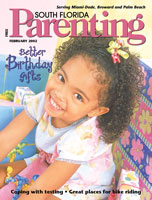 |
|
Available
in the February issue of South Florida Parenting
|
All feelings
are okay, it's what you do with them that counts
Young
children are learning how to manage stress, cope with frustration, generate appropriate
solutions to challenges and get along with others. As parents and caregivers,
you can promote emotional well being by encouraging your children's healthy expression
of feelings. When children learn how to express themselves, they are learning
important skills for life.
What to Expect at Each Age and Stage of Development
11 Ways to Encourage Emotional Expression
Take Care of Yourself!
Recommended Activities
Download a Printable Version (requires Acrobat
Reader)
What
to Expect at Each Age and Stage of Development
- Watch your infant. Babies
can experience a variety of complex emotions including happiness, sadness and
fear. Your baby's first life lesson is to develop feelings of trust. Respond to
your baby's cries, provide physical comfort and plenty of love and attention.
- Active toddlers are learning
about the world, becoming more independent and gradually developing the skills
needed to express feelings through actions and words. Children at this age want
to feed themselves, dress themselves and make their feelings known by saying "no"
and "mine." Support your toddler's quest for independence. Provide age-appropriate
opportunities for your toddler to make choices. For example, "Do you want
to wear the red shirt or the blue shirt today? You choose."
- Preschoolers love to play.
They can express a wide range of emotions and are learning to make friends and
resolve conflicts. Remember, be patient. These lessons take time! You can help
children express themselves and master challenges through play. "Maybe
'Arthur' feels sad because 'D.W.' took his toy from him." Your imaginative
preschooler may enjoy helping these favorite characters find practical and peaceful
solutions to problems.
- Kids express their feelings
differently than adults. Tantruming, crying and whining can be common during the
early years. Find opportunities to encourage the appropriate expression of feelings.
Your children can gradually find the words to express their feelings with your
support. For example, if your child cries when leaving a party, you can say "I
know you feel sad because it's time to leave. It's hard to leave a party when
you're having fun."
- School age children can
understand and express an even wider range of emotions. You can help by listening
and providing responses like "It hurts when a friend teases you, I understand."
When children feel understood, they are more likely to find effective solutions
to challenges. In time, and with your support, your child can learn to handle
frustration, disappointment and other challenges. With these skills, children
gain feelings of confidence, self-esteem and competence.
top
11
Ways to Encourage Emotional Expression
- Listen to your child. Through
understanding and acceptance from a parent, children gradually learn how to manage
their own emotions and respect the feelings of others.
- Pay attention to body language.
Read cues. Many feelings are communicated through facial expressions and gestures.
- Notice and encourage your
child's positive behaviors and ignore minor misbehaviors, when appropriate.
- Label both your feelings
and your child's feelings. "You seem scared when the thunder makes a loud
noise." "I'm so excited to go to the park with you."
When you acknowledge emotions and label them, children learn to recognize feelings
and talk about them too.
- Model acceptable forms
of expression. Children take their cues from the way we express our feelings.
- Know the difference between
your child's feelings and behavior. Limits need to be set if a child is physically
hurting someone else, but your child's feelings can still be validated in this
situation. Let your child know it's okay to feel angry but it's not okay to hurt
others. Parents can provide appropriate consequences for this behavior, and offer
alternative forms of expression -- sending the message that all feelings are okay,
it's what you do with them that counts!
- Openly show affection,
and be available when your child appears frustrated, sad or fearful. Use your
words and actions to let your child know it is safe to express any emotions.
- Encourage children to handle
and resolve conflicts with others without unnecessary intrusion by you. Your decision
regarding when and whether to intervene will be influenced by your children's
ages, temperaments and the specific circumstances of their disagreements.
- When children develop a
strong sense of empathy, they are less likely to act aggressively and more likely
to get along with others. Find daily opportunities to model empathy including
caring for a pet, donating clothing to others and calling a sick friend to see
how he is feeling.
- Seek alternatives to physical
punishment. Read books or enroll in a class to learn effective and respectful
discipline strategies.
- Maintain realistic expectations.
Be patient as your child is learning new skills.
top
Take
Care of Yourself!
- By maintaining your own
emotional health and well being, you are modeling important life skills to help
your child learn and grow.
- Take time to nurture yourself.
Take a walk, exercise, read a book, keep a journal or have coffee with a friend.
- Develop healthy, mutually
respectful relationships with others. When you relate with friends, family and
partners, your children will learn meaningful skills.
top
Recommended
Activities
- When reading books, talk
with your child about the characters and how they are feeling. Ask your child,
"How do you know he feels sad?" or "What makes her feel
happy in this story?"
- Create an "all about
me" book with your child. Include photos of your child and the family, favorite
foods, special friends, and pictures of things that make your child feel happy,
sad, mad, scared and excited.
- Use puppets, dolls and
stuffed animals to encourage your child to explore feelings through imaginative
play.
- When your child expresses
an interest in drawing, provide an array of art materials. Drawing and painting
often bring out the expression of feelings in creative ways.
- Mirror play can be fun.
Encourage your child to look in the mirror and make different "feelings faces."
Take turns making facial expressions that reflect a variety of emotions such as
happiness, surprise, sadness, fear, frustration, etc.
- Play the "guess how
I feel game." Take turns with your child "acting out" a range of
feelings without using words or language and guess what feelings are being expressed.
This interactive game helps children to read nonverbal cues and understand the
feelings of others.
If you are feeling overwhelmed
or have concerns about your child's mood, behavior or development, seek professional
support.

Written by Debbie Glasser, Ph.D. and Roni Leiderman, Ph.D. from the Mailman
Segal Institute at Nova Southeastern University in Cooperation with Channel
2's KidVision.
top
|


